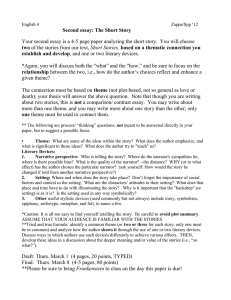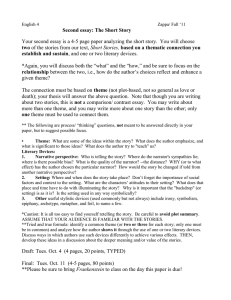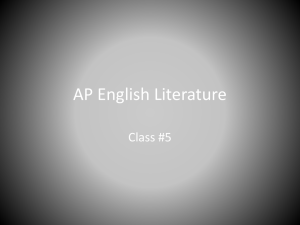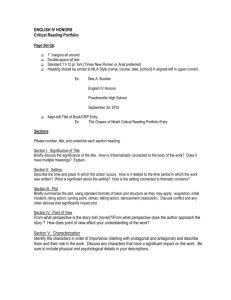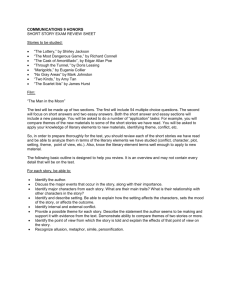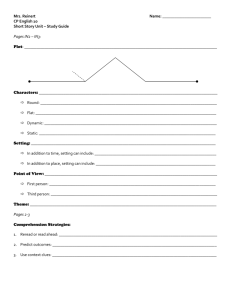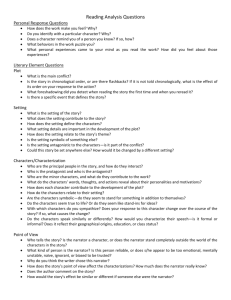SS Literary Analysis general KRAY
advertisement
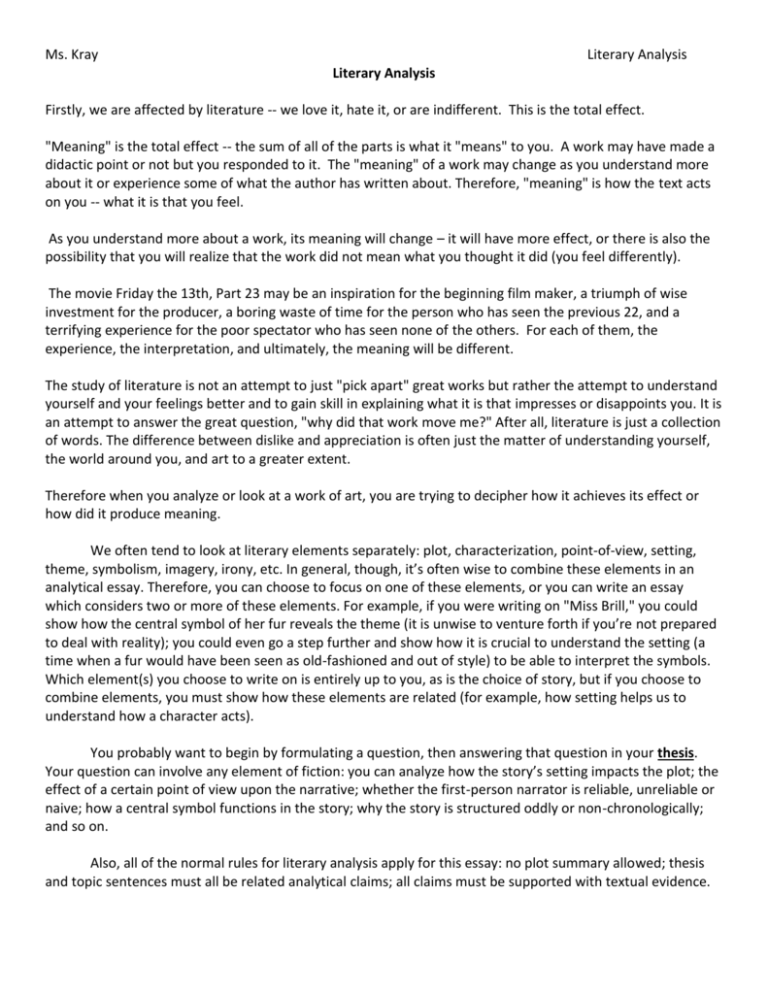
Ms. Kray Literary Analysis Literary Analysis Firstly, we are affected by literature -- we love it, hate it, or are indifferent. This is the total effect. "Meaning" is the total effect -- the sum of all of the parts is what it "means" to you. A work may have made a didactic point or not but you responded to it. The "meaning" of a work may change as you understand more about it or experience some of what the author has written about. Therefore, "meaning" is how the text acts on you -- what it is that you feel. As you understand more about a work, its meaning will change – it will have more effect, or there is also the possibility that you will realize that the work did not mean what you thought it did (you feel differently). The movie Friday the 13th, Part 23 may be an inspiration for the beginning film maker, a triumph of wise investment for the producer, a boring waste of time for the person who has seen the previous 22, and a terrifying experience for the poor spectator who has seen none of the others. For each of them, the experience, the interpretation, and ultimately, the meaning will be different. The study of literature is not an attempt to just "pick apart" great works but rather the attempt to understand yourself and your feelings better and to gain skill in explaining what it is that impresses or disappoints you. It is an attempt to answer the great question, "why did that work move me?" After all, literature is just a collection of words. The difference between dislike and appreciation is often just the matter of understanding yourself, the world around you, and art to a greater extent. Therefore when you analyze or look at a work of art, you are trying to decipher how it achieves its effect or how did it produce meaning. We often tend to look at literary elements separately: plot, characterization, point-of-view, setting, theme, symbolism, imagery, irony, etc. In general, though, it’s often wise to combine these elements in an analytical essay. Therefore, you can choose to focus on one of these elements, or you can write an essay which considers two or more of these elements. For example, if you were writing on "Miss Brill," you could show how the central symbol of her fur reveals the theme (it is unwise to venture forth if you’re not prepared to deal with reality); you could even go a step further and show how it is crucial to understand the setting (a time when a fur would have been seen as old-fashioned and out of style) to be able to interpret the symbols. Which element(s) you choose to write on is entirely up to you, as is the choice of story, but if you choose to combine elements, you must show how these elements are related (for example, how setting helps us to understand how a character acts). You probably want to begin by formulating a question, then answering that question in your thesis. Your question can involve any element of fiction: you can analyze how the story’s setting impacts the plot; the effect of a certain point of view upon the narrative; whether the first-person narrator is reliable, unreliable or naive; how a central symbol functions in the story; why the story is structured oddly or non-chronologically; and so on. Also, all of the normal rules for literary analysis apply for this essay: no plot summary allowed; thesis and topic sentences must all be related analytical claims; all claims must be supported with textual evidence. General Questions to Consider Below are some general questions that you can apply to any work of fiction, although you can come up with your own questions or approach. I. Analysis of Structure tells us how a work’s organization influences (or is influenced by) the plot and theme or the work. Structural analysis usually involves one or more of the following considerations: A. Why is chronological order adhered to or violated? B. How is the central conflict presented and resolved? C. How does the author use structure to evoke an emotional response? II. Analysis of Imagery and Symbolism involves telling us why an author chooses to use one or more dominant, recurring images or symbols. Consider if these symbols help to: A. Evoke emotions B. Establish mood C. Reinforce characterization D. Help convey the theme III. Point-of-View Analysis attempts to explain why the author chose a particular narrative perspective, and how this viewpoint affects the reader’s perception of the work. Here are some things to consider: A. Is the narrator a character in the story (first person) or not (third person)? B. How objective is the narrator? C. How limited are his/her perceptions? D. Why does the narrator choose certain language, report the details that he/she does, reveal the characters in the manner that he/she does, offer or not offer interpretive comments, and/or tell the story in a certain order? IV. Analysis of Setting and Atmosphere attempts to explain how and why a work’s time and place affects the events and/or the characters of the work. Often you will want to consider setting as part of another form of literary analysis. Here are some things to consider: A. Why is the work set during a certain era, season or time of day? B. Is any part of the setting symbolic? C. How well does a character "fit in" with the setting? D. Does the setting establish atmosphere or mood? V. Analysis of Theme involves determining the concept, thought, opinion or belief that the author is expressing. Again, it is very common (and helpful) to consider theme when analyzing another aspect of literature. Two main questions to consider are: A. Does it seem like the author is making a value judgment? B. How does the author convey his/her ideas? Is it through: 1. Direct statements 2. Imagery and symbolism 3. A character’s thoughts or statements 4. A character who stands for an idea or 5. The total impression of the work?


